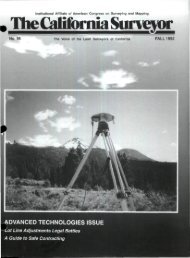Sacramento Surveyors Visit the NGS Airborne Gravimeter - CLSA
Sacramento Surveyors Visit the NGS Airborne Gravimeter - CLSA
Sacramento Surveyors Visit the NGS Airborne Gravimeter - CLSA
You also want an ePaper? Increase the reach of your titles
YUMPU automatically turns print PDFs into web optimized ePapers that Google loves.
By: Robert Reese, PLS and Tom Mastin, PLS<br />
Positioning Using GPS and CORS<br />
Part I – Overview of GPS and<br />
Continuous GPS Stations (CGPSS)<br />
Continuous GPS Stations (CGPSS) are permanently<br />
placed GPS receivers used by <strong>the</strong> academic and<br />
research community to monitor minute changes in <strong>the</strong><br />
shape of <strong>the</strong> earth. Most surveyors are familiar with <strong>the</strong><br />
Continuously Operating Reference Stations (CORS) that are<br />
managed by <strong>NGS</strong>. In this article “CORS” refers to official<br />
<strong>NGS</strong> stations and “CGPSS” is <strong>the</strong> generic term for<br />
Continuous GPS stations.<br />
As with everything <strong>the</strong>se days, surveyors want <strong>the</strong><br />
quick fix that RTK surveying gives <strong>the</strong>m. We could average<br />
a number of readings, but waiting 5 seconds to get a position<br />
is just soooo slooow. Give me a number and give it to<br />
me now! It must be good since <strong>the</strong> data collector is showing<br />
<strong>the</strong> value to 0.0001 of a foot and it is in color! (Or so<br />
some people think.) RTK GPS excels in certain surveying<br />
tasks, but as with all tools, RTK has limitations.<br />
There are times when relative accuracy might be a little<br />
more important than color. GPS is a very good tool to provide<br />
accurate relative positions for two survey points. In<br />
fact <strong>the</strong>re are times when it would be nice to know where<br />
you are on some kind of datum thing. This series of articles<br />
is going to discuss post-processing static GPS observations,<br />
including <strong>the</strong> options available for determining <strong>the</strong><br />
receiver’s relative positions using CGPSS to process Static<br />
and Rapid-Static GPS sessions. We will look at on-line<br />
services that can process your GPS observations as well as<br />
how to obtain data files from CGPSS to use in your processing<br />
software. We will not discuss adjustment techniques<br />
for GPS sessions, only how to relate your surveys to<br />
CGPSS.<br />
History<br />
The predecessor to CORS came about in <strong>the</strong> late<br />
1980’s to provide fixed ground locations to compute more<br />
precise orbits for <strong>the</strong> satellites. As early as 1991, <strong>the</strong>re were<br />
21 operating stations installed for this purpose. <strong>NGS</strong> officially<br />
began CORS in 1994, with subsequent interest by <strong>the</strong><br />
US Coast Guard; <strong>the</strong> US Army Corps of Engineers and <strong>the</strong><br />
FAA expanded <strong>the</strong> network. It is probably <strong>the</strong> interest by<br />
NASA’s JPL and <strong>the</strong> US Geological Survey in studying<br />
crustal motion that contributed to <strong>the</strong> accelerated CORS<br />
network expansion for civilian uses. Since GPS is a very<br />
good relative positioning tool, small movements - cyclical,<br />
secular or episodic - could be monitored in near-real time to<br />
detect relative motions of large areas. California was one of<br />
<strong>the</strong> premier places to make <strong>the</strong>se studies as this is where<br />
<strong>the</strong> North American Plate meets <strong>the</strong> Pacific Plate, and <strong>the</strong>re<br />
is a great deal of earthquake activity.<br />
For more information regarding <strong>the</strong> history of CORS,<br />
go to: http://www.lacoastpost.com/SnaySolerCORS-<br />
JSE08.pdf.<br />
Datums, datums, my kingdom for only one datum.<br />
In this article we won’t try to untangle <strong>the</strong> mess we<br />
know as datums. This article acknowledges that <strong>the</strong> current<br />
reference frame of <strong>the</strong> North American Datum of 1983<br />
(NAD83) is called <strong>the</strong> National Spatial Reference System of<br />
2007 (NSRS2007). Also we will discuss <strong>the</strong> NAD83<br />
Continuously Operating Reference System of 1996 (CORS<br />
96) and a little bit about <strong>the</strong> International Terrestrial<br />
Reference Frame of 2000 (ITRF 2000) and 2005 (ITRF<br />
2005). What is important for a surveyor to understand when<br />
working with <strong>the</strong>se datums is that you must choose a consistent<br />
“epoch” or date for positions. Your epoch date does<br />
not have to be <strong>the</strong> date of <strong>the</strong> GPS survey, but it must be<br />
consistent for all positions for <strong>the</strong> survey.<br />
On <strong>NGS</strong> Survey Data sheets and o<strong>the</strong>r official documents<br />
an epoch is shown as a year and decimal year. The<br />
epoch date for 1991.35 denotes approximately May 8,<br />
1991, <strong>the</strong> midpoint of California’s High Precision Geodetic<br />
Network (HPGN) observations. NAD83 (NSRS2007) has an<br />
epoch date of 2007.00, or January 1, 2007. Some of <strong>the</strong><br />
CORS datasheets will also show an epoch of <strong>the</strong> date for<br />
<strong>the</strong>ir NAD83 coordinates.<br />
Continued on next page<br />
34<br />
www.californiasurveyors.org
















